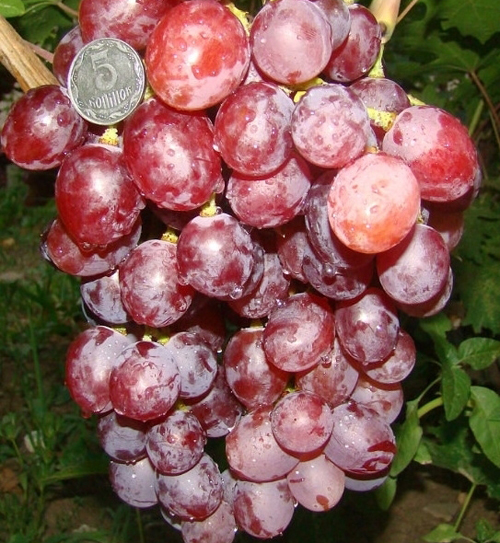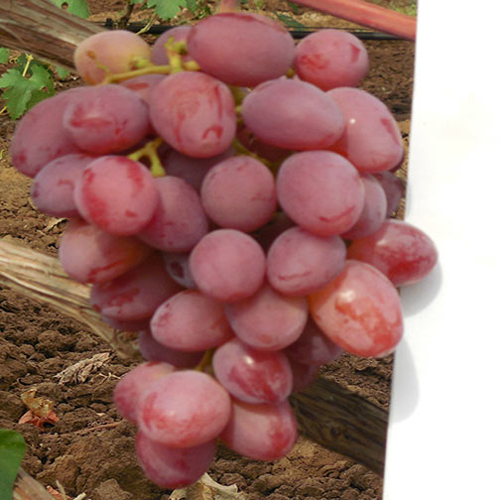Ruta grape variety
Ruta, a hybrid form of table grapes, is one of the many varieties developed over the past decade by representatives of amateur selection. Its author is the famous Ukrainian national breeder Vitaliy Zagorulko. As a maternal form he used the most famous large-fruited variety Mascot, and paternal - no less famous Radiant kishmish... The parental couple can be called classic, since through it many new hybrids were born both for Zagorulko and his colleagues in the workshop.

During the period of his active research activity, Vitaly Vladimirovich presented dozens of author's developments to the court of winegrowers, some of which instantly gained popularity, and were even included in the state registers of varieties of Russia and Ukraine, while others were much less in demand.
In all this diversity, Ruta was in the middle in terms of popularity. Due to its excellent appearance and very early ripening of the bunches, it deservedly enjoys the interest of buyers of grape seedlings, but at the same time, certain disadvantages limit its distribution on a large scale. Such flaws in her are a functionally female type of flowering, which is why pollinating varieties must be present on the site, as well as not too high plant resistance to fungal diseases, especially to powdery mildew.
But despite these contradictions, the variety is quite often found in household and garden plots, where, subject to careful care for it, it pleases its owners with an amazing harvest from an aesthetic point of view.
Agrobiological characteristics
Plants are characterized by very vigorous growth, especially those grown in their own rooted culture. The crown of a young shoot of grapes is closed, yellowish-green in color with a slight cobweb pubescence of light tones. Young leaves of Ruta are wrinkled, light green, reddish dots can be seen along their edges. A typical leaf is large, rounded, held on a long, reddish petiole due to intense anthocyanin pigmentation. The leaf blade is flat or funnel-shaped, deep green, reticulate-wrinkled, consists of five lobes with a strong dissection between them. Leaf veins are light, reddish at the base. The upper lateral incisions are deep, often closed with an ovoid lumen, less often open lyre-shaped, slit-like, or V-shaped. The lower notches are shallower in depth, but their shape can also vary quite significantly. The petiolate notch is predominantly open, lyre-shaped or vaulted with a pointed bottom. The teeth along the perimeter of the leaf are large, triangular and saw-shaped, with an average width of the bases and slightly curved edges. The flowers are functionally female, not capable of self-pollination. Because of this, with insufficient cross-fertilization with other varieties, pea berries can often be observed. Annual shoots ripen well, and the vine becomes reddish-brown.

This grape variety is distinguished by the large size of the bunches and their visual appeal in case of sufficient pollination. The average mass of a well-executed brush ranges from 550-700 grams, the shape is usually conical, the density is moderate. Thanks to the free arrangement of the grapes, they do not damage each other, do not wrinkle or deform. Ruta's combs are of medium length, light green, herbaceous. Nipple-shaped in shape, the berries are painted in a very delicate, pleasing to the eye pink color and are covered with a light layer of a light waxy coating. They can reach 36 mm in length and 22 mm in diameter, which characterizes them as large and very large. Weight, depending on the size, varies between 7-12 grams.The pulp of this variety is dense, fleshy, has an excellent balanced taste with a neutral aroma and aftertaste. The juice squeezed from grapes is slightly pink due to the colored pulp, its sugar content can reach 20 g / 100ml. Data on acidity are not presented, but judging by the harmony of the taste of berries, its indicators do not exceed the norm. The skin is quite thin, and therefore almost intangible when eaten. Although the seeds are present, they also do not worsen the gastronomic characteristics of the grapes too much.
The main purpose of Ruta's harvest is fresh consumption. If it is possible to prevent the peas of berries, then the bunches are amazing in their presentation and can be very successful when sold on the market. This is additionally facilitated by the very early ripening of the crop, when the choice on the shelves is already not great, and such beautiful bunches are completely exclusive. Another factor appreciated by farmers is the good transportability of the crop, which means the ability to transport it over long distances without compromising its visual appeal. Fans of homemade preparations for the winter will surely enjoy the wonderful juices, compotes of preserves and jams from it. Canned berries impart their excellent color and gastronomic sophistication to the finished product. But for long-term storage, like other thin-skinned varieties, this grape is not particularly suitable.
The growing season is very short. Less than a hundred days pass from budding to the onset of maturity of the bunches, and in the south, harvesting can begin in late July - early August. The sum of active temperatures during this time does not exceed 2150-2250 ° C, and the variety is rightfully classified as a super-early one, capable of growing not only in areas traditional for viticulture, but also in many northern regions. So, for example, the level of heat supply required by our heroine is quite accessible when cultivating in the Moscow region, not to mention more southern territories. At the same time, however, it is necessary to take into account the low frost resistance of the aboveground part of the bushes, which can withstand temperatures only up to -21 ° C without shelter. In this regard, Ruta is almost everywhere grown with insulation for the winter, and in northern conditions this procedure is carried out especially carefully.
Own-rooted plantations quickly enter the fruiting stage, and often already in the second year please their owners with the so-called "signal" bunches. However, the yield of mature bushes is estimated as average, even despite the large size of the plants. The reason for this is the same insufficient pollination of unisexual flowers, however, if desired and with certain labor costs, this problem is solved, and the bushes form and easily pull up to 15-20 kilograms of grapes. In young plants, mature brushes may be smaller than standard ones, however, as perennial wood grows, this problem disappears. The variety, as a rule, is not prone to overloads, and a similar problem can manifest itself only locally, while maintaining two or more bunches on one shoot. In this case, the brushes and berries may grow less than their usual values, and the palatability of the fruit may decrease due to the appearance of the watery pulp. It is also impossible not to mention the possibility of obtaining two harvests per season - the main one and the stepson's, which is, albeit a small, but nevertheless a pleasant bonus when growing Ruta.
Ripe berries are not prone to cracking, but in rainy weather they can get sick with gray rot. If there are dry days, then the grapes can be kept well on the bushes for several weeks. Wasps, in general, also bypass our heroine, thanks to which protection from them is very rarely required.
Agrotechnical features
The economic characteristics of our heroine can be assessed as ambiguous. On the one hand, it does not show special requirements for soil and climatic conditions of cultivation, and on the other hand, it needs a fairly responsible care of itself.
The variety can be planted on a wide variety of soil types, excluding only saline and overly acidic areas.In addition, damp and wetlands will not be suitable for a vineyard, and at a high level of groundwater, plants will develop inhibited.
Reproduction of grapes is carried out by rooted cuttings in those places where the soil is not infected with phylloxera, and in regions where the pest is present - by seedlings grafted onto phylloxera-resistant rootstocks. In the latter case, as rootstock forms, it is better to choose those that limit the active growth of the scion, for example, Riparia x Rupestris 101-14. The feeding area of Ruta's bushes should be at least 4.5-5 square meters.
Young plants begin to give the desired shape from the second year. The bushes are formed according to the principle of squat, stampless schemes, like an inclined cordon or a multi-arm fan. Such options allow in the future to easily remove the vine from the trellis to cover it for the winter.
In order to ensure a high yield of the variety, in a fruiting vineyard, spring pruning is carried out on 8-12 buds with a total load of up to 50 eyes. Barren shoots are removed during debris, and during flowering it is highly desirable to carry out additional manual pollination using pollen of bisexual forms of grapes.
To protect against fungal diseases, multiple complex spraying of plants with fungicides will be required, but one should not neglect such agrotechnical methods as, for example, lightening the fruit zone, which allows to reduce the harmfulness of gray rot due to good ventilation of the bunches and lighting them with the sun.








